Comparative Analysis: Business Operations of Ford, GM, and Toyota
VerifiedAdded on 2020/10/05
|12
|4161
|199
Report
AI Summary
This report provides a detailed analysis of business operations, focusing on the strategies employed by Ford, General Motors (GM), and Toyota. It begins with an introduction to business operations, emphasizing the importance of efficient internal processes. The main body delves into Toyota's operational improvement strategies, including the Kaizen model, Six Sigma, Total Quality Management (TQM), and the four-stage model of operations contribution. The Kaizen model is explained in detail, including its five elements (SEIRI, SEITON, SEISO, SEIKETSU, and SHITSUKE), and how it fosters continuous improvement. The Six Sigma model, also known as DMAIC, is presented as a structured approach to improve product and service quality. The report also explores TQM and its impact on customer satisfaction and internal processes, and the four-stage model of operations contribution, which focuses on strategic impact and operational capabilities. The report concludes with actionable advice for Ford and GM on implementing Toyota's successful operational strategies to regain market share, offering a comprehensive guide for understanding and improving business operations.
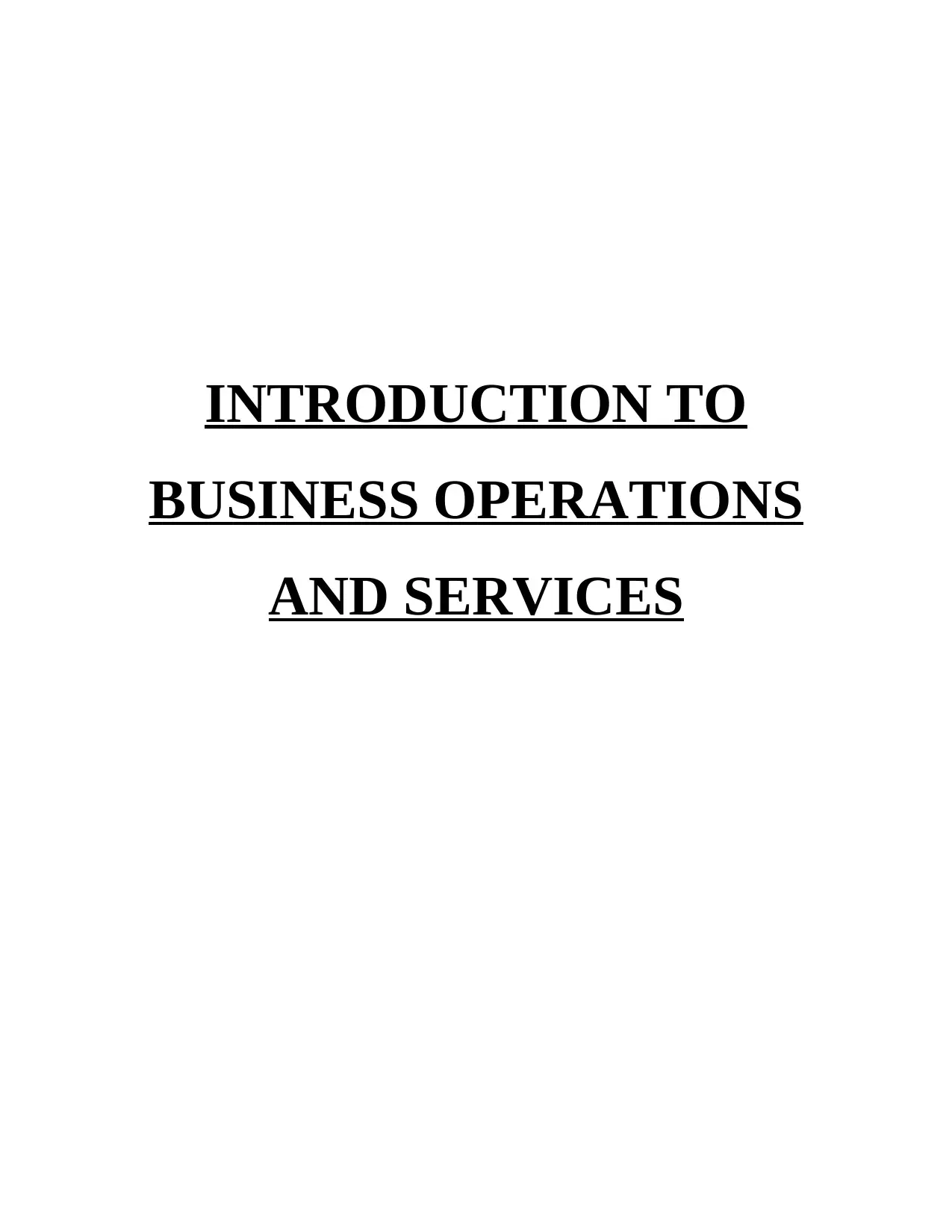
INTRODUCTION TO
BUSINESS OPERATIONS
AND SERVICES
BUSINESS OPERATIONS
AND SERVICES
Paraphrase This Document
Need a fresh take? Get an instant paraphrase of this document with our AI Paraphraser
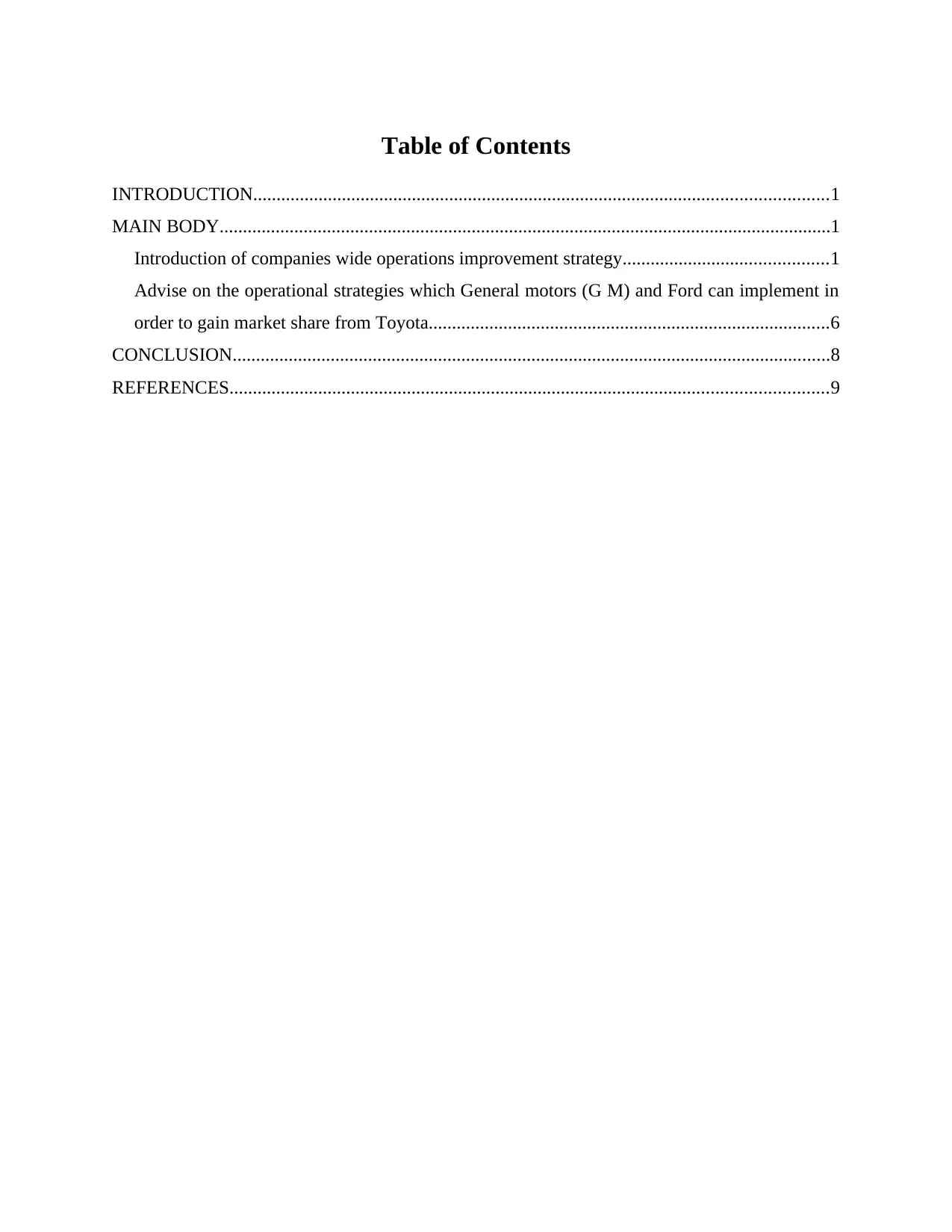
Table of Contents
INTRODUCTION...........................................................................................................................1
MAIN BODY...................................................................................................................................1
Introduction of companies wide operations improvement strategy............................................1
Advise on the operational strategies which General motors (G M) and Ford can implement in
order to gain market share from Toyota......................................................................................6
CONCLUSION................................................................................................................................8
REFERENCES................................................................................................................................9
INTRODUCTION...........................................................................................................................1
MAIN BODY...................................................................................................................................1
Introduction of companies wide operations improvement strategy............................................1
Advise on the operational strategies which General motors (G M) and Ford can implement in
order to gain market share from Toyota......................................................................................6
CONCLUSION................................................................................................................................8
REFERENCES................................................................................................................................9
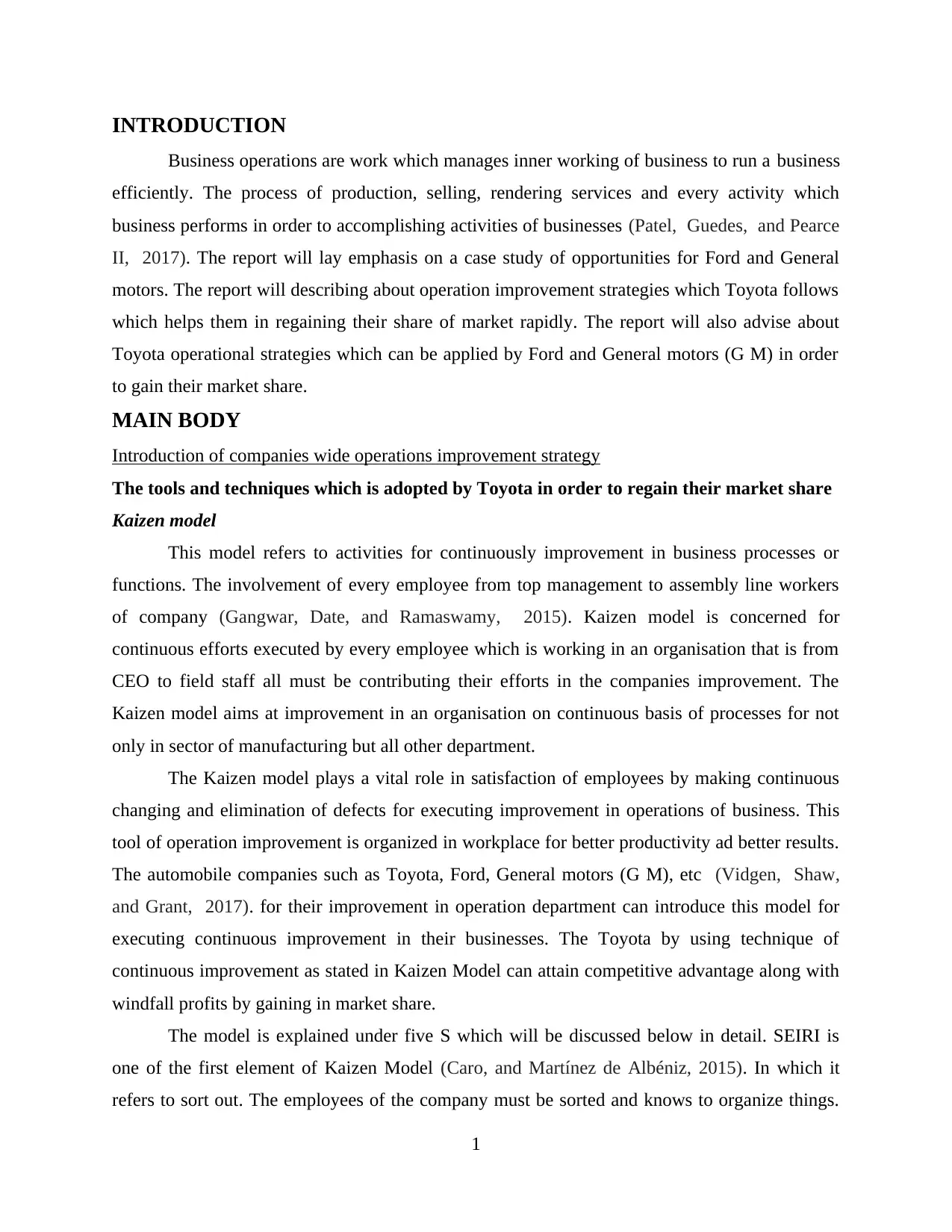
INTRODUCTION
Business operations are work which manages inner working of business to run a business
efficiently. The process of production, selling, rendering services and every activity which
business performs in order to accomplishing activities of businesses (Patel, Guedes, and Pearce
II, 2017). The report will lay emphasis on a case study of opportunities for Ford and General
motors. The report will describing about operation improvement strategies which Toyota follows
which helps them in regaining their share of market rapidly. The report will also advise about
Toyota operational strategies which can be applied by Ford and General motors (G M) in order
to gain their market share.
MAIN BODY
Introduction of companies wide operations improvement strategy
The tools and techniques which is adopted by Toyota in order to regain their market share
Kaizen model
This model refers to activities for continuously improvement in business processes or
functions. The involvement of every employee from top management to assembly line workers
of company (Gangwar, Date, and Ramaswamy, 2015). Kaizen model is concerned for
continuous efforts executed by every employee which is working in an organisation that is from
CEO to field staff all must be contributing their efforts in the companies improvement. The
Kaizen model aims at improvement in an organisation on continuous basis of processes for not
only in sector of manufacturing but all other department.
The Kaizen model plays a vital role in satisfaction of employees by making continuous
changing and elimination of defects for executing improvement in operations of business. This
tool of operation improvement is organized in workplace for better productivity ad better results.
The automobile companies such as Toyota, Ford, General motors (G M), etc (Vidgen, Shaw,
and Grant, 2017). for their improvement in operation department can introduce this model for
executing continuous improvement in their businesses. The Toyota by using technique of
continuous improvement as stated in Kaizen Model can attain competitive advantage along with
windfall profits by gaining in market share.
The model is explained under five S which will be discussed below in detail. SEIRI is
one of the first element of Kaizen Model (Caro, and Martínez de Albéniz, 2015). In which it
refers to sort out. The employees of the company must be sorted and knows to organize things.
1
Business operations are work which manages inner working of business to run a business
efficiently. The process of production, selling, rendering services and every activity which
business performs in order to accomplishing activities of businesses (Patel, Guedes, and Pearce
II, 2017). The report will lay emphasis on a case study of opportunities for Ford and General
motors. The report will describing about operation improvement strategies which Toyota follows
which helps them in regaining their share of market rapidly. The report will also advise about
Toyota operational strategies which can be applied by Ford and General motors (G M) in order
to gain their market share.
MAIN BODY
Introduction of companies wide operations improvement strategy
The tools and techniques which is adopted by Toyota in order to regain their market share
Kaizen model
This model refers to activities for continuously improvement in business processes or
functions. The involvement of every employee from top management to assembly line workers
of company (Gangwar, Date, and Ramaswamy, 2015). Kaizen model is concerned for
continuous efforts executed by every employee which is working in an organisation that is from
CEO to field staff all must be contributing their efforts in the companies improvement. The
Kaizen model aims at improvement in an organisation on continuous basis of processes for not
only in sector of manufacturing but all other department.
The Kaizen model plays a vital role in satisfaction of employees by making continuous
changing and elimination of defects for executing improvement in operations of business. This
tool of operation improvement is organized in workplace for better productivity ad better results.
The automobile companies such as Toyota, Ford, General motors (G M), etc (Vidgen, Shaw,
and Grant, 2017). for their improvement in operation department can introduce this model for
executing continuous improvement in their businesses. The Toyota by using technique of
continuous improvement as stated in Kaizen Model can attain competitive advantage along with
windfall profits by gaining in market share.
The model is explained under five S which will be discussed below in detail. SEIRI is
one of the first element of Kaizen Model (Caro, and Martínez de Albéniz, 2015). In which it
refers to sort out. The employees of the company must be sorted and knows to organize things.
1
⊘ This is a preview!⊘
Do you want full access?
Subscribe today to unlock all pages.

Trusted by 1+ million students worldwide
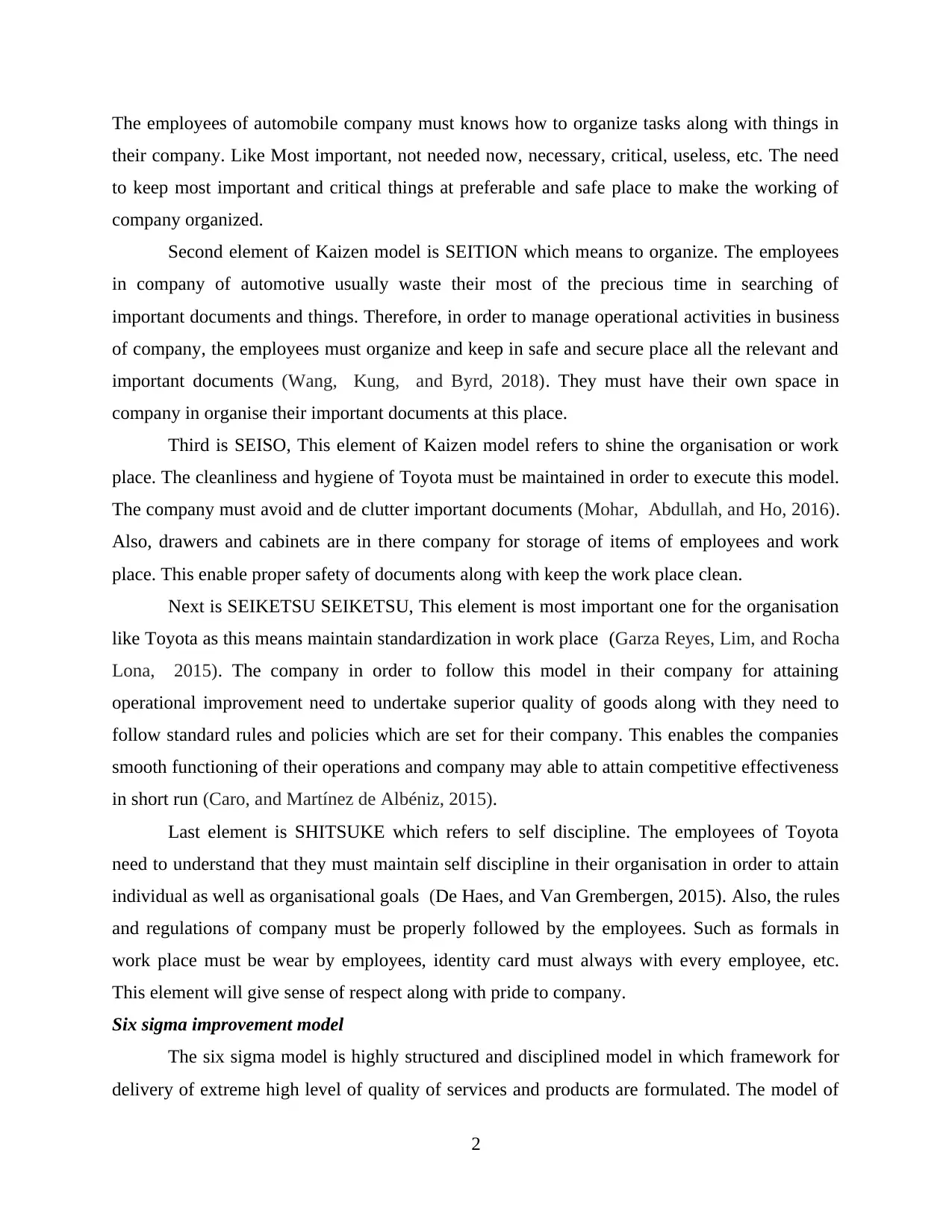
The employees of automobile company must knows how to organize tasks along with things in
their company. Like Most important, not needed now, necessary, critical, useless, etc. The need
to keep most important and critical things at preferable and safe place to make the working of
company organized.
Second element of Kaizen model is SEITION which means to organize. The employees
in company of automotive usually waste their most of the precious time in searching of
important documents and things. Therefore, in order to manage operational activities in business
of company, the employees must organize and keep in safe and secure place all the relevant and
important documents (Wang, Kung, and Byrd, 2018). They must have their own space in
company in organise their important documents at this place.
Third is SEISO, This element of Kaizen model refers to shine the organisation or work
place. The cleanliness and hygiene of Toyota must be maintained in order to execute this model.
The company must avoid and de clutter important documents (Mohar, Abdullah, and Ho, 2016).
Also, drawers and cabinets are in there company for storage of items of employees and work
place. This enable proper safety of documents along with keep the work place clean.
Next is SEIKETSU SEIKETSU, This element is most important one for the organisation
like Toyota as this means maintain standardization in work place (Garza Reyes, Lim, and Rocha
Lona, 2015). The company in order to follow this model in their company for attaining
operational improvement need to undertake superior quality of goods along with they need to
follow standard rules and policies which are set for their company. This enables the companies
smooth functioning of their operations and company may able to attain competitive effectiveness
in short run (Caro, and Martínez de Albéniz, 2015).
Last element is SHITSUKE which refers to self discipline. The employees of Toyota
need to understand that they must maintain self discipline in their organisation in order to attain
individual as well as organisational goals (De Haes, and Van Grembergen, 2015). Also, the rules
and regulations of company must be properly followed by the employees. Such as formals in
work place must be wear by employees, identity card must always with every employee, etc.
This element will give sense of respect along with pride to company.
Six sigma improvement model
The six sigma model is highly structured and disciplined model in which framework for
delivery of extreme high level of quality of services and products are formulated. The model of
2
their company. Like Most important, not needed now, necessary, critical, useless, etc. The need
to keep most important and critical things at preferable and safe place to make the working of
company organized.
Second element of Kaizen model is SEITION which means to organize. The employees
in company of automotive usually waste their most of the precious time in searching of
important documents and things. Therefore, in order to manage operational activities in business
of company, the employees must organize and keep in safe and secure place all the relevant and
important documents (Wang, Kung, and Byrd, 2018). They must have their own space in
company in organise their important documents at this place.
Third is SEISO, This element of Kaizen model refers to shine the organisation or work
place. The cleanliness and hygiene of Toyota must be maintained in order to execute this model.
The company must avoid and de clutter important documents (Mohar, Abdullah, and Ho, 2016).
Also, drawers and cabinets are in there company for storage of items of employees and work
place. This enable proper safety of documents along with keep the work place clean.
Next is SEIKETSU SEIKETSU, This element is most important one for the organisation
like Toyota as this means maintain standardization in work place (Garza Reyes, Lim, and Rocha
Lona, 2015). The company in order to follow this model in their company for attaining
operational improvement need to undertake superior quality of goods along with they need to
follow standard rules and policies which are set for their company. This enables the companies
smooth functioning of their operations and company may able to attain competitive effectiveness
in short run (Caro, and Martínez de Albéniz, 2015).
Last element is SHITSUKE which refers to self discipline. The employees of Toyota
need to understand that they must maintain self discipline in their organisation in order to attain
individual as well as organisational goals (De Haes, and Van Grembergen, 2015). Also, the rules
and regulations of company must be properly followed by the employees. Such as formals in
work place must be wear by employees, identity card must always with every employee, etc.
This element will give sense of respect along with pride to company.
Six sigma improvement model
The six sigma model is highly structured and disciplined model in which framework for
delivery of extreme high level of quality of services and products are formulated. The model of
2
Paraphrase This Document
Need a fresh take? Get an instant paraphrase of this document with our AI Paraphraser
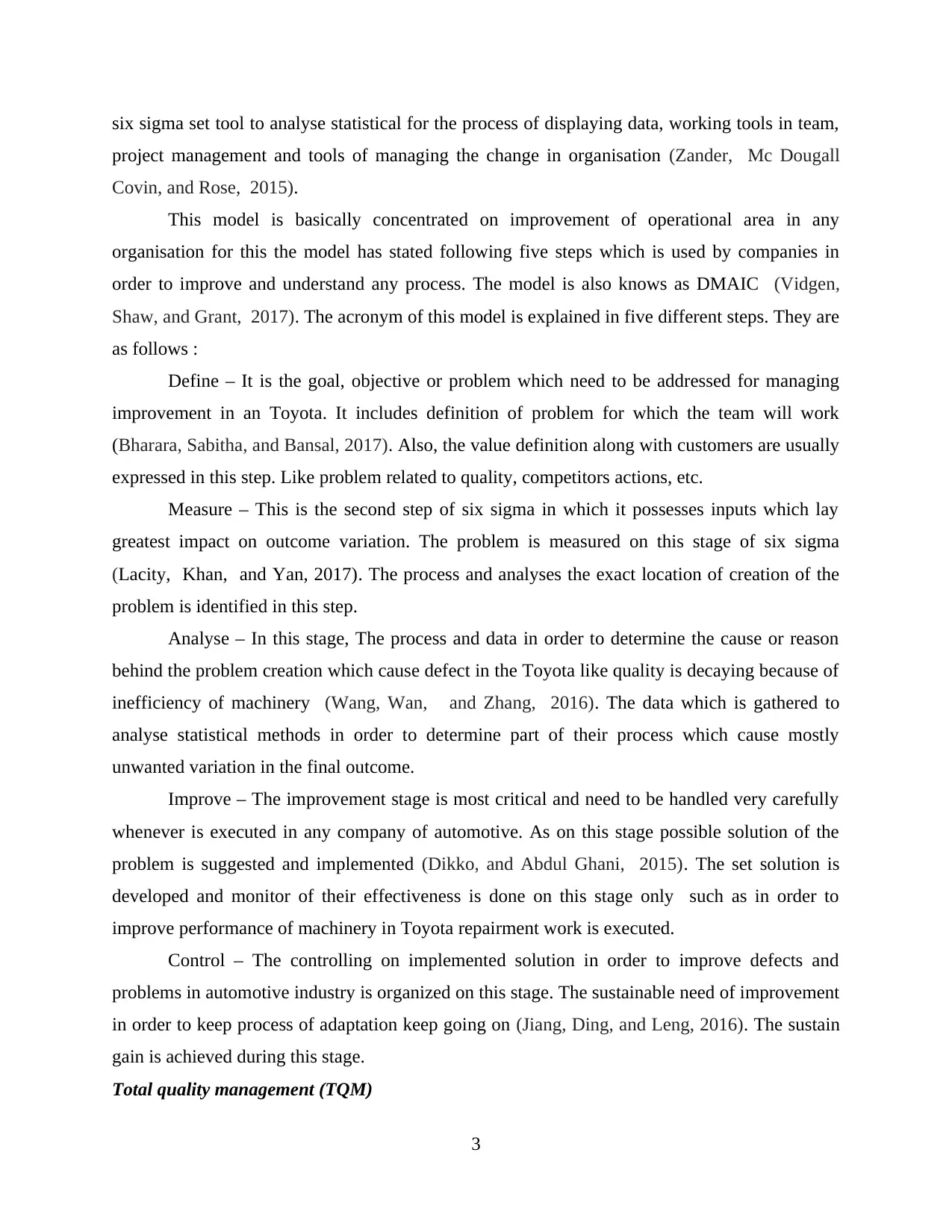
six sigma set tool to analyse statistical for the process of displaying data, working tools in team,
project management and tools of managing the change in organisation (Zander, Mc Dougall
Covin, and Rose, 2015).
This model is basically concentrated on improvement of operational area in any
organisation for this the model has stated following five steps which is used by companies in
order to improve and understand any process. The model is also knows as DMAIC (Vidgen,
Shaw, and Grant, 2017). The acronym of this model is explained in five different steps. They are
as follows :
Define – It is the goal, objective or problem which need to be addressed for managing
improvement in an Toyota. It includes definition of problem for which the team will work
(Bharara, Sabitha, and Bansal, 2017). Also, the value definition along with customers are usually
expressed in this step. Like problem related to quality, competitors actions, etc.
Measure – This is the second step of six sigma in which it possesses inputs which lay
greatest impact on outcome variation. The problem is measured on this stage of six sigma
(Lacity, Khan, and Yan, 2017). The process and analyses the exact location of creation of the
problem is identified in this step.
Analyse – In this stage, The process and data in order to determine the cause or reason
behind the problem creation which cause defect in the Toyota like quality is decaying because of
inefficiency of machinery (Wang, Wan, and Zhang, 2016). The data which is gathered to
analyse statistical methods in order to determine part of their process which cause mostly
unwanted variation in the final outcome.
Improve – The improvement stage is most critical and need to be handled very carefully
whenever is executed in any company of automotive. As on this stage possible solution of the
problem is suggested and implemented (Dikko, and Abdul Ghani, 2015). The set solution is
developed and monitor of their effectiveness is done on this stage only such as in order to
improve performance of machinery in Toyota repairment work is executed.
Control – The controlling on implemented solution in order to improve defects and
problems in automotive industry is organized on this stage. The sustainable need of improvement
in order to keep process of adaptation keep going on (Jiang, Ding, and Leng, 2016). The sustain
gain is achieved during this stage.
Total quality management (TQM)
3
project management and tools of managing the change in organisation (Zander, Mc Dougall
Covin, and Rose, 2015).
This model is basically concentrated on improvement of operational area in any
organisation for this the model has stated following five steps which is used by companies in
order to improve and understand any process. The model is also knows as DMAIC (Vidgen,
Shaw, and Grant, 2017). The acronym of this model is explained in five different steps. They are
as follows :
Define – It is the goal, objective or problem which need to be addressed for managing
improvement in an Toyota. It includes definition of problem for which the team will work
(Bharara, Sabitha, and Bansal, 2017). Also, the value definition along with customers are usually
expressed in this step. Like problem related to quality, competitors actions, etc.
Measure – This is the second step of six sigma in which it possesses inputs which lay
greatest impact on outcome variation. The problem is measured on this stage of six sigma
(Lacity, Khan, and Yan, 2017). The process and analyses the exact location of creation of the
problem is identified in this step.
Analyse – In this stage, The process and data in order to determine the cause or reason
behind the problem creation which cause defect in the Toyota like quality is decaying because of
inefficiency of machinery (Wang, Wan, and Zhang, 2016). The data which is gathered to
analyse statistical methods in order to determine part of their process which cause mostly
unwanted variation in the final outcome.
Improve – The improvement stage is most critical and need to be handled very carefully
whenever is executed in any company of automotive. As on this stage possible solution of the
problem is suggested and implemented (Dikko, and Abdul Ghani, 2015). The set solution is
developed and monitor of their effectiveness is done on this stage only such as in order to
improve performance of machinery in Toyota repairment work is executed.
Control – The controlling on implemented solution in order to improve defects and
problems in automotive industry is organized on this stage. The sustainable need of improvement
in order to keep process of adaptation keep going on (Jiang, Ding, and Leng, 2016). The sustain
gain is achieved during this stage.
Total quality management (TQM)
3
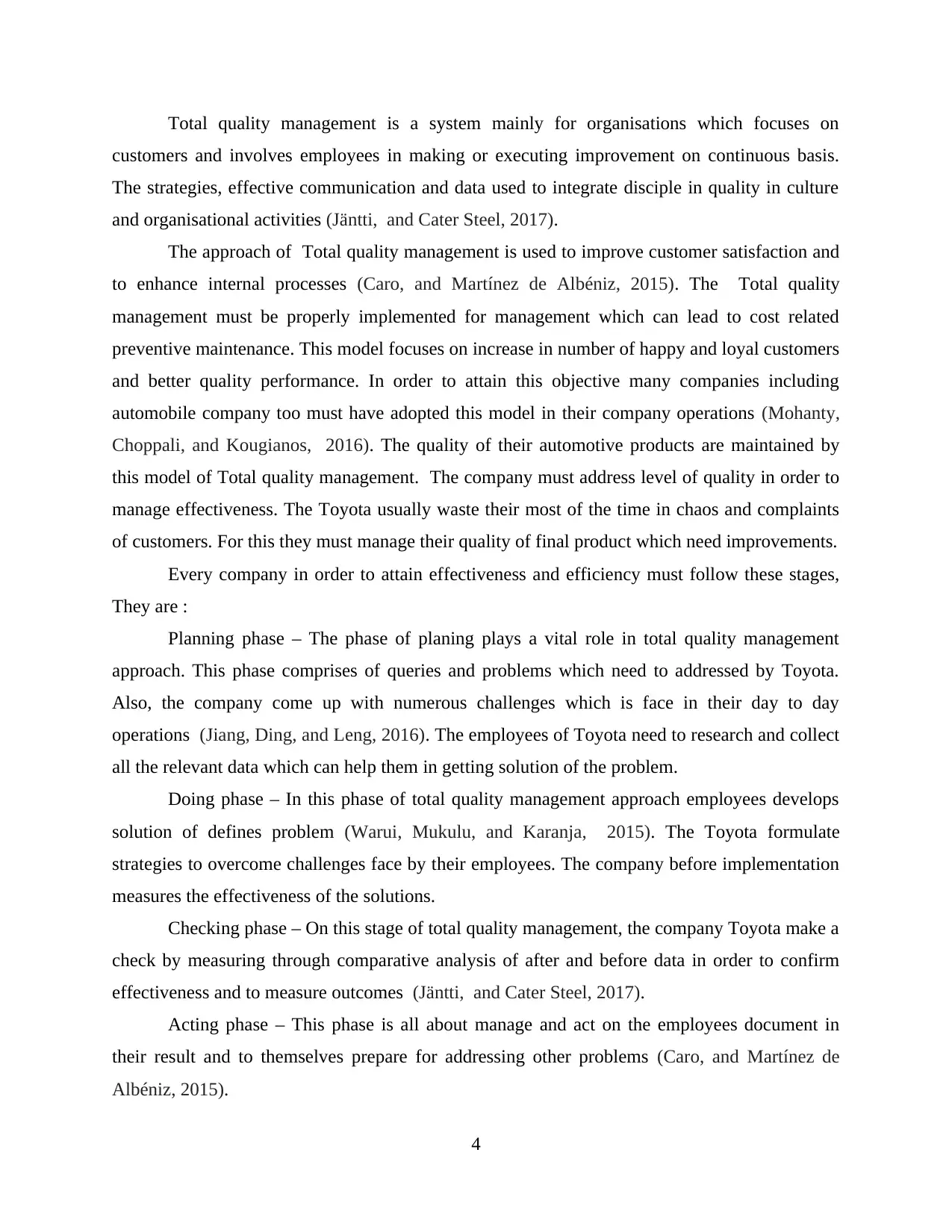
Total quality management is a system mainly for organisations which focuses on
customers and involves employees in making or executing improvement on continuous basis.
The strategies, effective communication and data used to integrate disciple in quality in culture
and organisational activities (Jäntti, and Cater Steel, 2017).
The approach of Total quality management is used to improve customer satisfaction and
to enhance internal processes (Caro, and Martínez de Albéniz, 2015). The Total quality
management must be properly implemented for management which can lead to cost related
preventive maintenance. This model focuses on increase in number of happy and loyal customers
and better quality performance. In order to attain this objective many companies including
automobile company too must have adopted this model in their company operations (Mohanty,
Choppali, and Kougianos, 2016). The quality of their automotive products are maintained by
this model of Total quality management. The company must address level of quality in order to
manage effectiveness. The Toyota usually waste their most of the time in chaos and complaints
of customers. For this they must manage their quality of final product which need improvements.
Every company in order to attain effectiveness and efficiency must follow these stages,
They are :
Planning phase – The phase of planing plays a vital role in total quality management
approach. This phase comprises of queries and problems which need to addressed by Toyota.
Also, the company come up with numerous challenges which is face in their day to day
operations (Jiang, Ding, and Leng, 2016). The employees of Toyota need to research and collect
all the relevant data which can help them in getting solution of the problem.
Doing phase – In this phase of total quality management approach employees develops
solution of defines problem (Warui, Mukulu, and Karanja, 2015). The Toyota formulate
strategies to overcome challenges face by their employees. The company before implementation
measures the effectiveness of the solutions.
Checking phase – On this stage of total quality management, the company Toyota make a
check by measuring through comparative analysis of after and before data in order to confirm
effectiveness and to measure outcomes (Jäntti, and Cater Steel, 2017).
Acting phase – This phase is all about manage and act on the employees document in
their result and to themselves prepare for addressing other problems (Caro, and Martínez de
Albéniz, 2015).
4
customers and involves employees in making or executing improvement on continuous basis.
The strategies, effective communication and data used to integrate disciple in quality in culture
and organisational activities (Jäntti, and Cater Steel, 2017).
The approach of Total quality management is used to improve customer satisfaction and
to enhance internal processes (Caro, and Martínez de Albéniz, 2015). The Total quality
management must be properly implemented for management which can lead to cost related
preventive maintenance. This model focuses on increase in number of happy and loyal customers
and better quality performance. In order to attain this objective many companies including
automobile company too must have adopted this model in their company operations (Mohanty,
Choppali, and Kougianos, 2016). The quality of their automotive products are maintained by
this model of Total quality management. The company must address level of quality in order to
manage effectiveness. The Toyota usually waste their most of the time in chaos and complaints
of customers. For this they must manage their quality of final product which need improvements.
Every company in order to attain effectiveness and efficiency must follow these stages,
They are :
Planning phase – The phase of planing plays a vital role in total quality management
approach. This phase comprises of queries and problems which need to addressed by Toyota.
Also, the company come up with numerous challenges which is face in their day to day
operations (Jiang, Ding, and Leng, 2016). The employees of Toyota need to research and collect
all the relevant data which can help them in getting solution of the problem.
Doing phase – In this phase of total quality management approach employees develops
solution of defines problem (Warui, Mukulu, and Karanja, 2015). The Toyota formulate
strategies to overcome challenges face by their employees. The company before implementation
measures the effectiveness of the solutions.
Checking phase – On this stage of total quality management, the company Toyota make a
check by measuring through comparative analysis of after and before data in order to confirm
effectiveness and to measure outcomes (Jäntti, and Cater Steel, 2017).
Acting phase – This phase is all about manage and act on the employees document in
their result and to themselves prepare for addressing other problems (Caro, and Martínez de
Albéniz, 2015).
4
⊘ This is a preview!⊘
Do you want full access?
Subscribe today to unlock all pages.

Trusted by 1+ million students worldwide
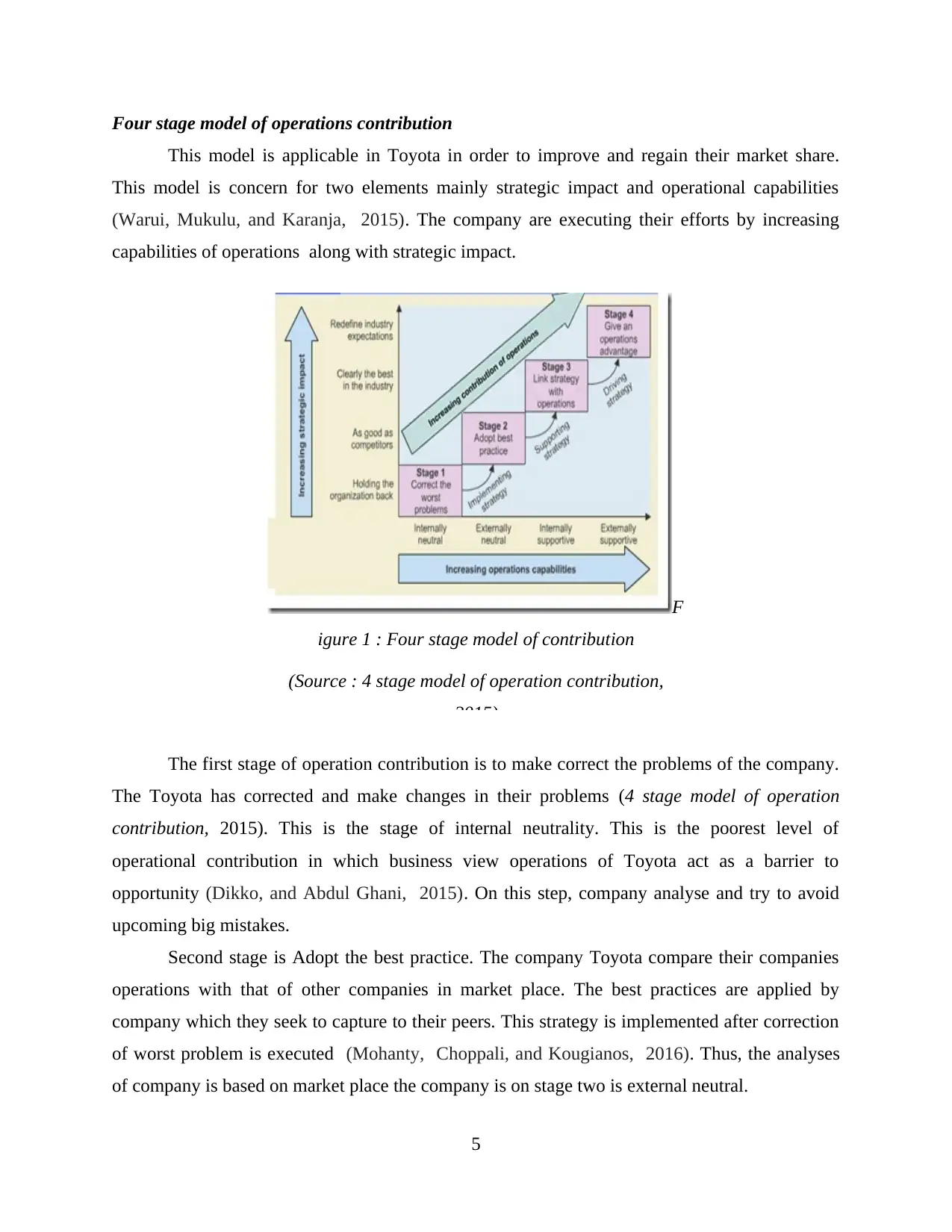
Four stage model of operations contribution
This model is applicable in Toyota in order to improve and regain their market share.
This model is concern for two elements mainly strategic impact and operational capabilities
(Warui, Mukulu, and Karanja, 2015). The company are executing their efforts by increasing
capabilities of operations along with strategic impact.
The first stage of operation contribution is to make correct the problems of the company.
The Toyota has corrected and make changes in their problems (4 stage model of operation
contribution, 2015). This is the stage of internal neutrality. This is the poorest level of
operational contribution in which business view operations of Toyota act as a barrier to
opportunity (Dikko, and Abdul Ghani, 2015). On this step, company analyse and try to avoid
upcoming big mistakes.
Second stage is Adopt the best practice. The company Toyota compare their companies
operations with that of other companies in market place. The best practices are applied by
company which they seek to capture to their peers. This strategy is implemented after correction
of worst problem is executed (Mohanty, Choppali, and Kougianos, 2016). Thus, the analyses
of company is based on market place the company is on stage two is external neutral.
5
F
igure 1 : Four stage model of contribution
(Source : 4 stage model of operation contribution,
2015)
This model is applicable in Toyota in order to improve and regain their market share.
This model is concern for two elements mainly strategic impact and operational capabilities
(Warui, Mukulu, and Karanja, 2015). The company are executing their efforts by increasing
capabilities of operations along with strategic impact.
The first stage of operation contribution is to make correct the problems of the company.
The Toyota has corrected and make changes in their problems (4 stage model of operation
contribution, 2015). This is the stage of internal neutrality. This is the poorest level of
operational contribution in which business view operations of Toyota act as a barrier to
opportunity (Dikko, and Abdul Ghani, 2015). On this step, company analyse and try to avoid
upcoming big mistakes.
Second stage is Adopt the best practice. The company Toyota compare their companies
operations with that of other companies in market place. The best practices are applied by
company which they seek to capture to their peers. This strategy is implemented after correction
of worst problem is executed (Mohanty, Choppali, and Kougianos, 2016). Thus, the analyses
of company is based on market place the company is on stage two is external neutral.
5
F
igure 1 : Four stage model of contribution
(Source : 4 stage model of operation contribution,
2015)
Paraphrase This Document
Need a fresh take? Get an instant paraphrase of this document with our AI Paraphraser
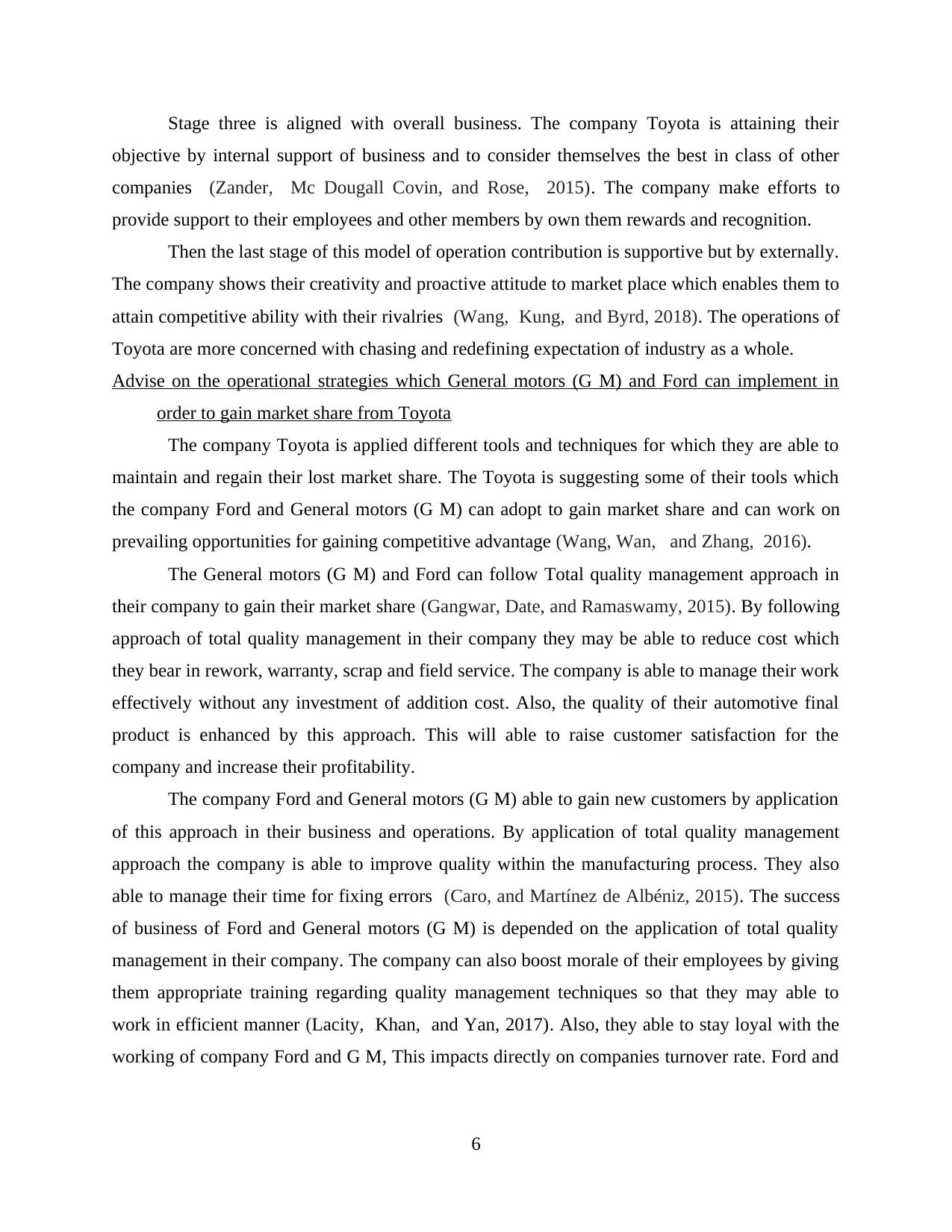
Stage three is aligned with overall business. The company Toyota is attaining their
objective by internal support of business and to consider themselves the best in class of other
companies (Zander, Mc Dougall Covin, and Rose, 2015). The company make efforts to
provide support to their employees and other members by own them rewards and recognition.
Then the last stage of this model of operation contribution is supportive but by externally.
The company shows their creativity and proactive attitude to market place which enables them to
attain competitive ability with their rivalries (Wang, Kung, and Byrd, 2018). The operations of
Toyota are more concerned with chasing and redefining expectation of industry as a whole.
Advise on the operational strategies which General motors (G M) and Ford can implement in
order to gain market share from Toyota
The company Toyota is applied different tools and techniques for which they are able to
maintain and regain their lost market share. The Toyota is suggesting some of their tools which
the company Ford and General motors (G M) can adopt to gain market share and can work on
prevailing opportunities for gaining competitive advantage (Wang, Wan, and Zhang, 2016).
The General motors (G M) and Ford can follow Total quality management approach in
their company to gain their market share (Gangwar, Date, and Ramaswamy, 2015). By following
approach of total quality management in their company they may be able to reduce cost which
they bear in rework, warranty, scrap and field service. The company is able to manage their work
effectively without any investment of addition cost. Also, the quality of their automotive final
product is enhanced by this approach. This will able to raise customer satisfaction for the
company and increase their profitability.
The company Ford and General motors (G M) able to gain new customers by application
of this approach in their business and operations. By application of total quality management
approach the company is able to improve quality within the manufacturing process. They also
able to manage their time for fixing errors (Caro, and Martínez de Albéniz, 2015). The success
of business of Ford and General motors (G M) is depended on the application of total quality
management in their company. The company can also boost morale of their employees by giving
them appropriate training regarding quality management techniques so that they may able to
work in efficient manner (Lacity, Khan, and Yan, 2017). Also, they able to stay loyal with the
working of company Ford and G M, This impacts directly on companies turnover rate. Ford and
6
objective by internal support of business and to consider themselves the best in class of other
companies (Zander, Mc Dougall Covin, and Rose, 2015). The company make efforts to
provide support to their employees and other members by own them rewards and recognition.
Then the last stage of this model of operation contribution is supportive but by externally.
The company shows their creativity and proactive attitude to market place which enables them to
attain competitive ability with their rivalries (Wang, Kung, and Byrd, 2018). The operations of
Toyota are more concerned with chasing and redefining expectation of industry as a whole.
Advise on the operational strategies which General motors (G M) and Ford can implement in
order to gain market share from Toyota
The company Toyota is applied different tools and techniques for which they are able to
maintain and regain their lost market share. The Toyota is suggesting some of their tools which
the company Ford and General motors (G M) can adopt to gain market share and can work on
prevailing opportunities for gaining competitive advantage (Wang, Wan, and Zhang, 2016).
The General motors (G M) and Ford can follow Total quality management approach in
their company to gain their market share (Gangwar, Date, and Ramaswamy, 2015). By following
approach of total quality management in their company they may be able to reduce cost which
they bear in rework, warranty, scrap and field service. The company is able to manage their work
effectively without any investment of addition cost. Also, the quality of their automotive final
product is enhanced by this approach. This will able to raise customer satisfaction for the
company and increase their profitability.
The company Ford and General motors (G M) able to gain new customers by application
of this approach in their business and operations. By application of total quality management
approach the company is able to improve quality within the manufacturing process. They also
able to manage their time for fixing errors (Caro, and Martínez de Albéniz, 2015). The success
of business of Ford and General motors (G M) is depended on the application of total quality
management in their company. The company can also boost morale of their employees by giving
them appropriate training regarding quality management techniques so that they may able to
work in efficient manner (Lacity, Khan, and Yan, 2017). Also, they able to stay loyal with the
working of company Ford and G M, This impacts directly on companies turnover rate. Ford and
6
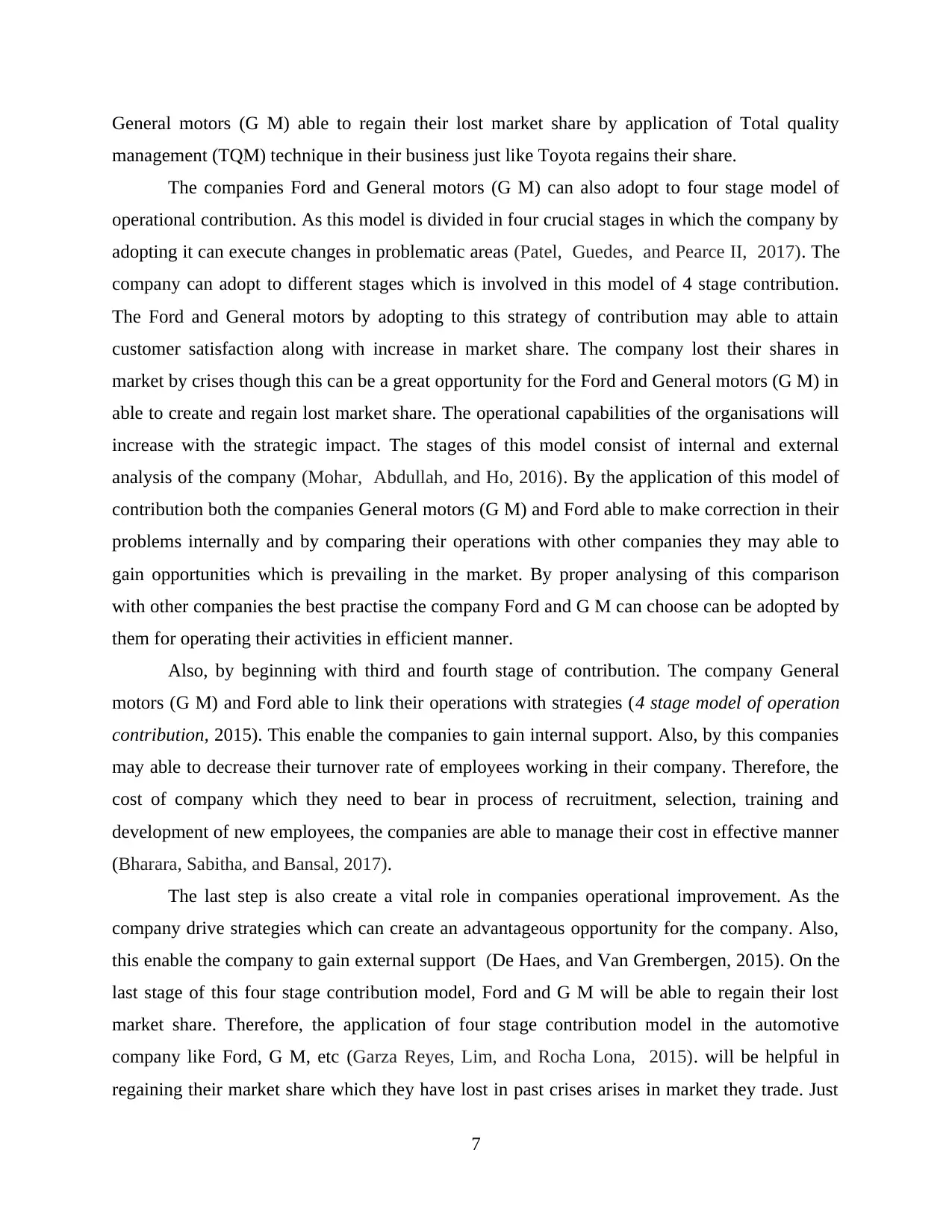
General motors (G M) able to regain their lost market share by application of Total quality
management (TQM) technique in their business just like Toyota regains their share.
The companies Ford and General motors (G M) can also adopt to four stage model of
operational contribution. As this model is divided in four crucial stages in which the company by
adopting it can execute changes in problematic areas (Patel, Guedes, and Pearce II, 2017). The
company can adopt to different stages which is involved in this model of 4 stage contribution.
The Ford and General motors by adopting to this strategy of contribution may able to attain
customer satisfaction along with increase in market share. The company lost their shares in
market by crises though this can be a great opportunity for the Ford and General motors (G M) in
able to create and regain lost market share. The operational capabilities of the organisations will
increase with the strategic impact. The stages of this model consist of internal and external
analysis of the company (Mohar, Abdullah, and Ho, 2016). By the application of this model of
contribution both the companies General motors (G M) and Ford able to make correction in their
problems internally and by comparing their operations with other companies they may able to
gain opportunities which is prevailing in the market. By proper analysing of this comparison
with other companies the best practise the company Ford and G M can choose can be adopted by
them for operating their activities in efficient manner.
Also, by beginning with third and fourth stage of contribution. The company General
motors (G M) and Ford able to link their operations with strategies (4 stage model of operation
contribution, 2015). This enable the companies to gain internal support. Also, by this companies
may able to decrease their turnover rate of employees working in their company. Therefore, the
cost of company which they need to bear in process of recruitment, selection, training and
development of new employees, the companies are able to manage their cost in effective manner
(Bharara, Sabitha, and Bansal, 2017).
The last step is also create a vital role in companies operational improvement. As the
company drive strategies which can create an advantageous opportunity for the company. Also,
this enable the company to gain external support (De Haes, and Van Grembergen, 2015). On the
last stage of this four stage contribution model, Ford and G M will be able to regain their lost
market share. Therefore, the application of four stage contribution model in the automotive
company like Ford, G M, etc (Garza Reyes, Lim, and Rocha Lona, 2015). will be helpful in
regaining their market share which they have lost in past crises arises in market they trade. Just
7
management (TQM) technique in their business just like Toyota regains their share.
The companies Ford and General motors (G M) can also adopt to four stage model of
operational contribution. As this model is divided in four crucial stages in which the company by
adopting it can execute changes in problematic areas (Patel, Guedes, and Pearce II, 2017). The
company can adopt to different stages which is involved in this model of 4 stage contribution.
The Ford and General motors by adopting to this strategy of contribution may able to attain
customer satisfaction along with increase in market share. The company lost their shares in
market by crises though this can be a great opportunity for the Ford and General motors (G M) in
able to create and regain lost market share. The operational capabilities of the organisations will
increase with the strategic impact. The stages of this model consist of internal and external
analysis of the company (Mohar, Abdullah, and Ho, 2016). By the application of this model of
contribution both the companies General motors (G M) and Ford able to make correction in their
problems internally and by comparing their operations with other companies they may able to
gain opportunities which is prevailing in the market. By proper analysing of this comparison
with other companies the best practise the company Ford and G M can choose can be adopted by
them for operating their activities in efficient manner.
Also, by beginning with third and fourth stage of contribution. The company General
motors (G M) and Ford able to link their operations with strategies (4 stage model of operation
contribution, 2015). This enable the companies to gain internal support. Also, by this companies
may able to decrease their turnover rate of employees working in their company. Therefore, the
cost of company which they need to bear in process of recruitment, selection, training and
development of new employees, the companies are able to manage their cost in effective manner
(Bharara, Sabitha, and Bansal, 2017).
The last step is also create a vital role in companies operational improvement. As the
company drive strategies which can create an advantageous opportunity for the company. Also,
this enable the company to gain external support (De Haes, and Van Grembergen, 2015). On the
last stage of this four stage contribution model, Ford and G M will be able to regain their lost
market share. Therefore, the application of four stage contribution model in the automotive
company like Ford, G M, etc (Garza Reyes, Lim, and Rocha Lona, 2015). will be helpful in
regaining their market share which they have lost in past crises arises in market they trade. Just
7
⊘ This is a preview!⊘
Do you want full access?
Subscribe today to unlock all pages.

Trusted by 1+ million students worldwide
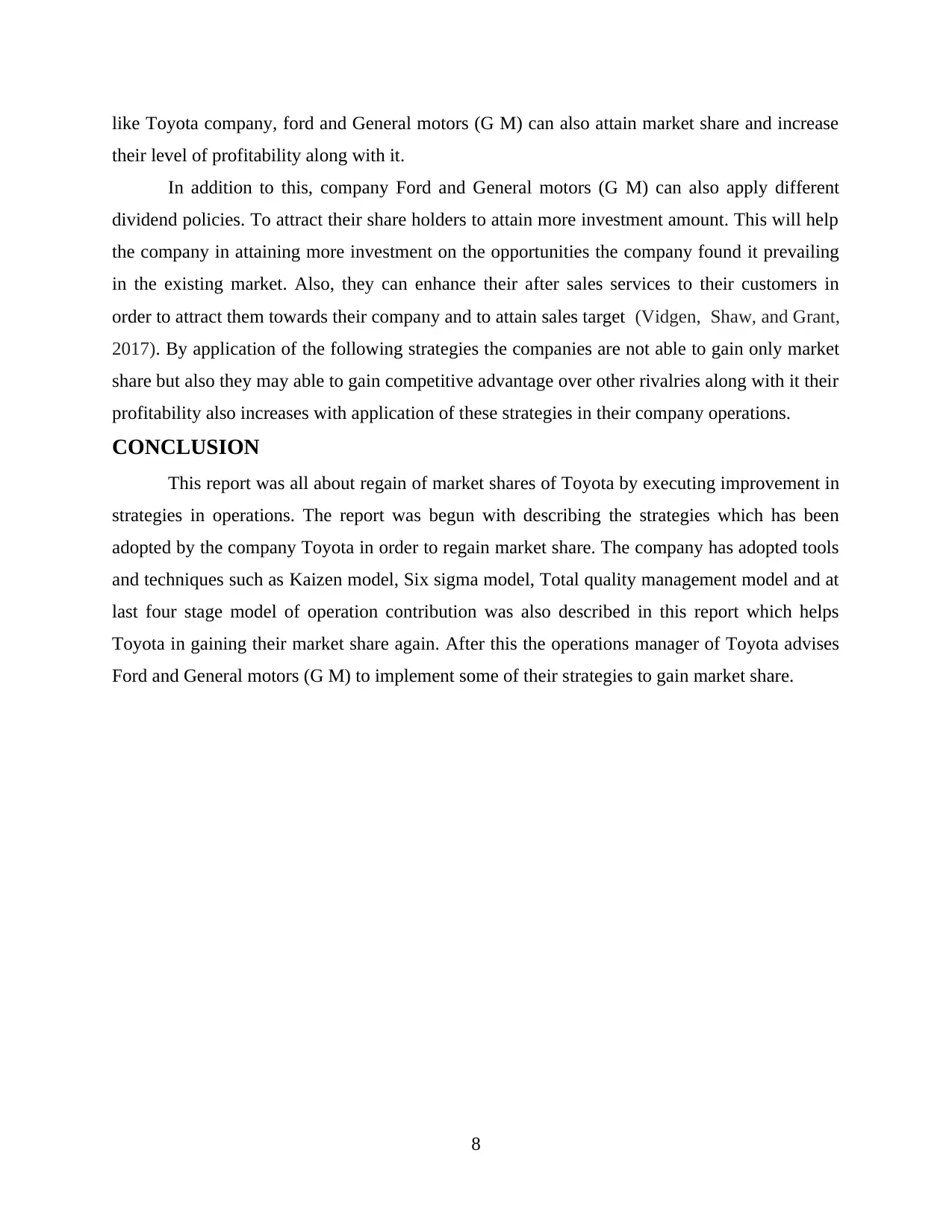
like Toyota company, ford and General motors (G M) can also attain market share and increase
their level of profitability along with it.
In addition to this, company Ford and General motors (G M) can also apply different
dividend policies. To attract their share holders to attain more investment amount. This will help
the company in attaining more investment on the opportunities the company found it prevailing
in the existing market. Also, they can enhance their after sales services to their customers in
order to attract them towards their company and to attain sales target (Vidgen, Shaw, and Grant,
2017). By application of the following strategies the companies are not able to gain only market
share but also they may able to gain competitive advantage over other rivalries along with it their
profitability also increases with application of these strategies in their company operations.
CONCLUSION
This report was all about regain of market shares of Toyota by executing improvement in
strategies in operations. The report was begun with describing the strategies which has been
adopted by the company Toyota in order to regain market share. The company has adopted tools
and techniques such as Kaizen model, Six sigma model, Total quality management model and at
last four stage model of operation contribution was also described in this report which helps
Toyota in gaining their market share again. After this the operations manager of Toyota advises
Ford and General motors (G M) to implement some of their strategies to gain market share.
8
their level of profitability along with it.
In addition to this, company Ford and General motors (G M) can also apply different
dividend policies. To attract their share holders to attain more investment amount. This will help
the company in attaining more investment on the opportunities the company found it prevailing
in the existing market. Also, they can enhance their after sales services to their customers in
order to attract them towards their company and to attain sales target (Vidgen, Shaw, and Grant,
2017). By application of the following strategies the companies are not able to gain only market
share but also they may able to gain competitive advantage over other rivalries along with it their
profitability also increases with application of these strategies in their company operations.
CONCLUSION
This report was all about regain of market shares of Toyota by executing improvement in
strategies in operations. The report was begun with describing the strategies which has been
adopted by the company Toyota in order to regain market share. The company has adopted tools
and techniques such as Kaizen model, Six sigma model, Total quality management model and at
last four stage model of operation contribution was also described in this report which helps
Toyota in gaining their market share again. After this the operations manager of Toyota advises
Ford and General motors (G M) to implement some of their strategies to gain market share.
8
Paraphrase This Document
Need a fresh take? Get an instant paraphrase of this document with our AI Paraphraser
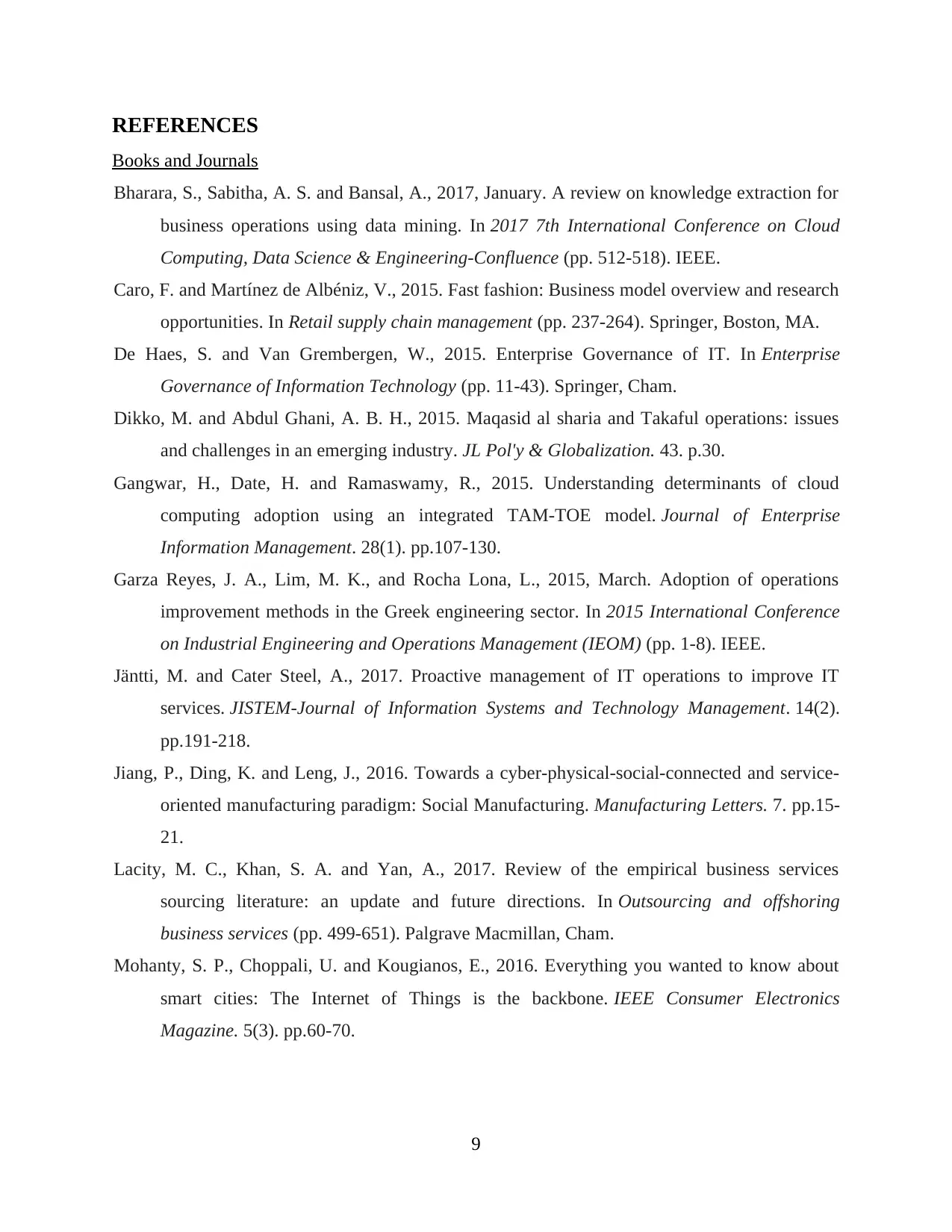
REFERENCES
Books and Journals
Bharara, S., Sabitha, A. S. and Bansal, A., 2017, January. A review on knowledge extraction for
business operations using data mining. In 2017 7th International Conference on Cloud
Computing, Data Science & Engineering-Confluence (pp. 512-518). IEEE.
Caro, F. and Martínez de Albéniz, V., 2015. Fast fashion: Business model overview and research
opportunities. In Retail supply chain management (pp. 237-264). Springer, Boston, MA.
De Haes, S. and Van Grembergen, W., 2015. Enterprise Governance of IT. In Enterprise
Governance of Information Technology (pp. 11-43). Springer, Cham.
Dikko, M. and Abdul Ghani, A. B. H., 2015. Maqasid al sharia and Takaful operations: issues
and challenges in an emerging industry. JL Pol'y & Globalization. 43. p.30.
Gangwar, H., Date, H. and Ramaswamy, R., 2015. Understanding determinants of cloud
computing adoption using an integrated TAM-TOE model. Journal of Enterprise
Information Management. 28(1). pp.107-130.
Garza Reyes, J. A., Lim, M. K., and Rocha Lona, L., 2015, March. Adoption of operations
improvement methods in the Greek engineering sector. In 2015 International Conference
on Industrial Engineering and Operations Management (IEOM) (pp. 1-8). IEEE.
Jäntti, M. and Cater Steel, A., 2017. Proactive management of IT operations to improve IT
services. JISTEM-Journal of Information Systems and Technology Management. 14(2).
pp.191-218.
Jiang, P., Ding, K. and Leng, J., 2016. Towards a cyber-physical-social-connected and service-
oriented manufacturing paradigm: Social Manufacturing. Manufacturing Letters. 7. pp.15-
21.
Lacity, M. C., Khan, S. A. and Yan, A., 2017. Review of the empirical business services
sourcing literature: an update and future directions. In Outsourcing and offshoring
business services (pp. 499-651). Palgrave Macmillan, Cham.
Mohanty, S. P., Choppali, U. and Kougianos, E., 2016. Everything you wanted to know about
smart cities: The Internet of Things is the backbone. IEEE Consumer Electronics
Magazine. 5(3). pp.60-70.
9
Books and Journals
Bharara, S., Sabitha, A. S. and Bansal, A., 2017, January. A review on knowledge extraction for
business operations using data mining. In 2017 7th International Conference on Cloud
Computing, Data Science & Engineering-Confluence (pp. 512-518). IEEE.
Caro, F. and Martínez de Albéniz, V., 2015. Fast fashion: Business model overview and research
opportunities. In Retail supply chain management (pp. 237-264). Springer, Boston, MA.
De Haes, S. and Van Grembergen, W., 2015. Enterprise Governance of IT. In Enterprise
Governance of Information Technology (pp. 11-43). Springer, Cham.
Dikko, M. and Abdul Ghani, A. B. H., 2015. Maqasid al sharia and Takaful operations: issues
and challenges in an emerging industry. JL Pol'y & Globalization. 43. p.30.
Gangwar, H., Date, H. and Ramaswamy, R., 2015. Understanding determinants of cloud
computing adoption using an integrated TAM-TOE model. Journal of Enterprise
Information Management. 28(1). pp.107-130.
Garza Reyes, J. A., Lim, M. K., and Rocha Lona, L., 2015, March. Adoption of operations
improvement methods in the Greek engineering sector. In 2015 International Conference
on Industrial Engineering and Operations Management (IEOM) (pp. 1-8). IEEE.
Jäntti, M. and Cater Steel, A., 2017. Proactive management of IT operations to improve IT
services. JISTEM-Journal of Information Systems and Technology Management. 14(2).
pp.191-218.
Jiang, P., Ding, K. and Leng, J., 2016. Towards a cyber-physical-social-connected and service-
oriented manufacturing paradigm: Social Manufacturing. Manufacturing Letters. 7. pp.15-
21.
Lacity, M. C., Khan, S. A. and Yan, A., 2017. Review of the empirical business services
sourcing literature: an update and future directions. In Outsourcing and offshoring
business services (pp. 499-651). Palgrave Macmillan, Cham.
Mohanty, S. P., Choppali, U. and Kougianos, E., 2016. Everything you wanted to know about
smart cities: The Internet of Things is the backbone. IEEE Consumer Electronics
Magazine. 5(3). pp.60-70.
9
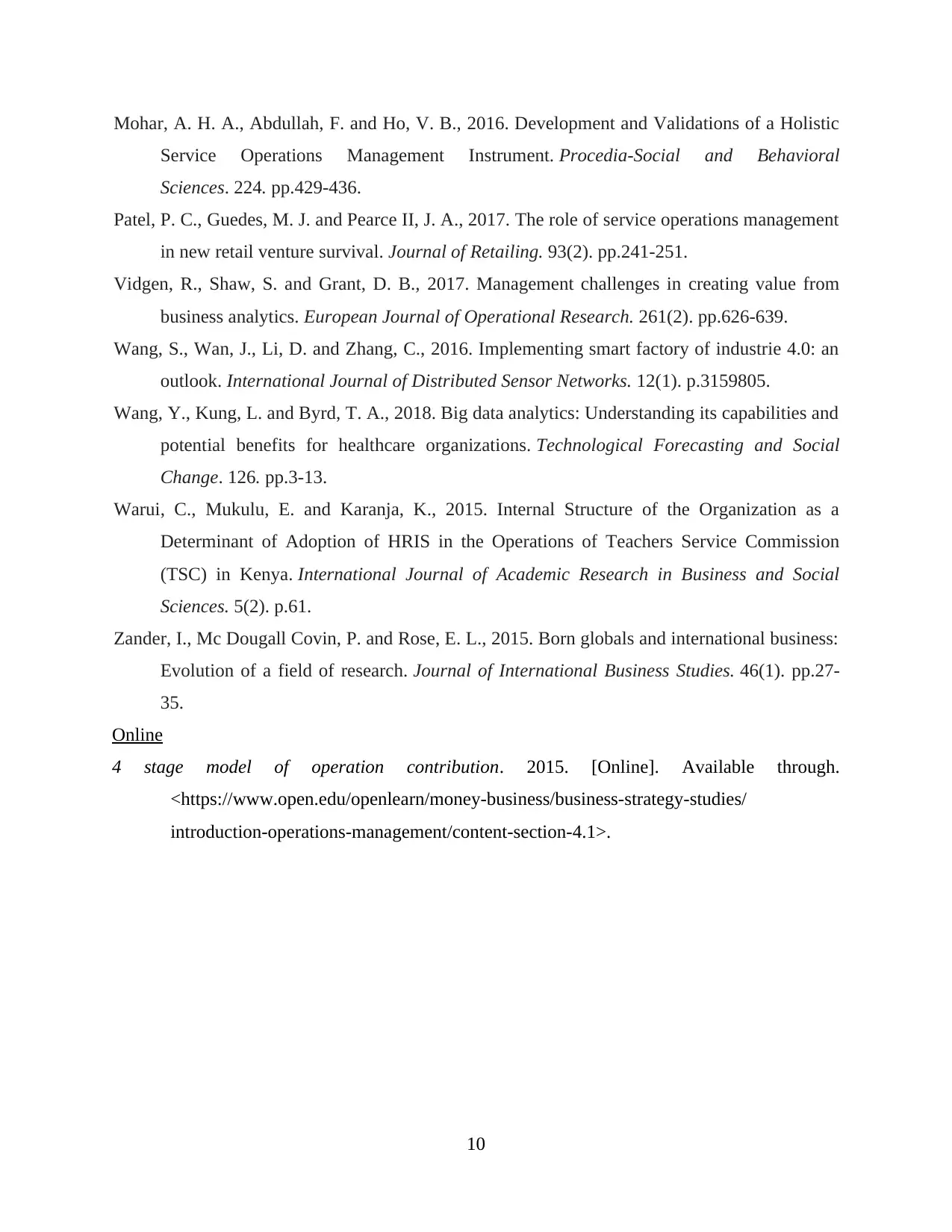
Mohar, A. H. A., Abdullah, F. and Ho, V. B., 2016. Development and Validations of a Holistic
Service Operations Management Instrument. Procedia-Social and Behavioral
Sciences. 224. pp.429-436.
Patel, P. C., Guedes, M. J. and Pearce II, J. A., 2017. The role of service operations management
in new retail venture survival. Journal of Retailing. 93(2). pp.241-251.
Vidgen, R., Shaw, S. and Grant, D. B., 2017. Management challenges in creating value from
business analytics. European Journal of Operational Research. 261(2). pp.626-639.
Wang, S., Wan, J., Li, D. and Zhang, C., 2016. Implementing smart factory of industrie 4.0: an
outlook. International Journal of Distributed Sensor Networks. 12(1). p.3159805.
Wang, Y., Kung, L. and Byrd, T. A., 2018. Big data analytics: Understanding its capabilities and
potential benefits for healthcare organizations. Technological Forecasting and Social
Change. 126. pp.3-13.
Warui, C., Mukulu, E. and Karanja, K., 2015. Internal Structure of the Organization as a
Determinant of Adoption of HRIS in the Operations of Teachers Service Commission
(TSC) in Kenya. International Journal of Academic Research in Business and Social
Sciences. 5(2). p.61.
Zander, I., Mc Dougall Covin, P. and Rose, E. L., 2015. Born globals and international business:
Evolution of a field of research. Journal of International Business Studies. 46(1). pp.27-
35.
Online
4 stage model of operation contribution. 2015. [Online]. Available through.
<https://www.open.edu/openlearn/money-business/business-strategy-studies/
introduction-operations-management/content-section-4.1>.
10
Service Operations Management Instrument. Procedia-Social and Behavioral
Sciences. 224. pp.429-436.
Patel, P. C., Guedes, M. J. and Pearce II, J. A., 2017. The role of service operations management
in new retail venture survival. Journal of Retailing. 93(2). pp.241-251.
Vidgen, R., Shaw, S. and Grant, D. B., 2017. Management challenges in creating value from
business analytics. European Journal of Operational Research. 261(2). pp.626-639.
Wang, S., Wan, J., Li, D. and Zhang, C., 2016. Implementing smart factory of industrie 4.0: an
outlook. International Journal of Distributed Sensor Networks. 12(1). p.3159805.
Wang, Y., Kung, L. and Byrd, T. A., 2018. Big data analytics: Understanding its capabilities and
potential benefits for healthcare organizations. Technological Forecasting and Social
Change. 126. pp.3-13.
Warui, C., Mukulu, E. and Karanja, K., 2015. Internal Structure of the Organization as a
Determinant of Adoption of HRIS in the Operations of Teachers Service Commission
(TSC) in Kenya. International Journal of Academic Research in Business and Social
Sciences. 5(2). p.61.
Zander, I., Mc Dougall Covin, P. and Rose, E. L., 2015. Born globals and international business:
Evolution of a field of research. Journal of International Business Studies. 46(1). pp.27-
35.
Online
4 stage model of operation contribution. 2015. [Online]. Available through.
<https://www.open.edu/openlearn/money-business/business-strategy-studies/
introduction-operations-management/content-section-4.1>.
10
⊘ This is a preview!⊘
Do you want full access?
Subscribe today to unlock all pages.

Trusted by 1+ million students worldwide
1 out of 12
Related Documents
Your All-in-One AI-Powered Toolkit for Academic Success.
+13062052269
info@desklib.com
Available 24*7 on WhatsApp / Email
![[object Object]](/_next/static/media/star-bottom.7253800d.svg)
Unlock your academic potential
Copyright © 2020–2025 A2Z Services. All Rights Reserved. Developed and managed by ZUCOL.




